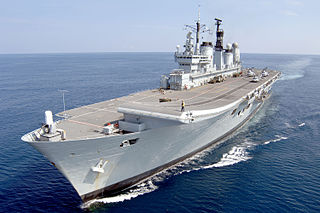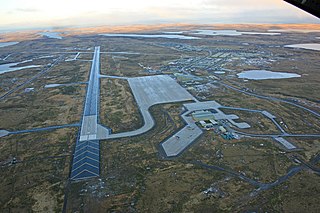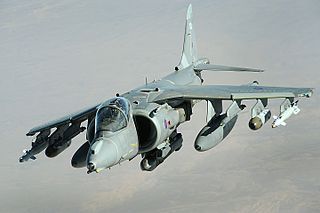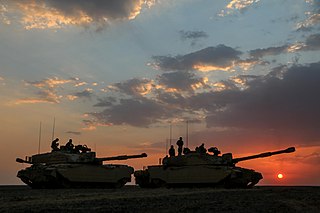
The Falkland Islands are a British overseas territory and, as such, rely on the United Kingdom for the guarantee of their security. The other UK territories in the South Atlantic, South Georgia and the South Sandwich Islands, fall under the protection of British Forces South Atlantic Islands (BFSAI), formerly known as British Forces Falkland Islands (BFFI), which includes commitments from the British Army, Royal Air Force and Royal Navy. They are headed by the Commander, British Forces South Atlantic Islands (CBFSAI), a brigadier-equivalent appointment that rotates among all three services.

The British Armed Forces are the military forces responsible for the defence of the United Kingdom, its Overseas Territories and the Crown Dependencies. They also promote the UK's wider interests, support international peacekeeping efforts and provide humanitarian aid.

The Fleet Air Arm (FAA) is the naval aviation component of the United Kingdom's Royal Navy (RN). The FAA is one of five RN fighting arms. As of 2023 it is a predominantly "rotary" force, with helicopters undertaking roles once performed by biplanes such as the Fairey Swordfish. It operates the F-35 Lightning II for maritime strike and the AW159 Wildcat and AW101 Merlin for commando and anti-submarine warfare.

The Invincible class was a class of light aircraft carrier operated by the Royal Navy. Three ships were constructed: HMS Invincible, HMS Illustrious and HMS Ark Royal. The vessels were built as aviation-capable anti-submarine warfare (ASW) platforms to counter the Cold War North Atlantic Soviet submarine threat, and initially embarked Sea Harrier aircraft and Sea King HAS.1 anti-submarine helicopters. With cancellation of the aircraft carriers renewal programme in the 1960s, the three ships became the replacements for Ark Royal and Eagle fleet carriers and the Centaur-class light fleet carriers, and the Royal Navy's sole class of aircraft carrier.

RAF Mount Pleasant is a Royal Air Force station in the British Overseas Territory of the Falkland Islands. The airfield goes by the motto of "Defend the right" and is part of the British Forces South Atlantic Islands (BFSAI). Home to between 1,000 and 2,000 British military personnel, it is about 33 miles (53 km) southwest of Stanley, the capital of the Falklands, on the island of East Falkland. The world's longest corridor, 2,600 feet (800 m) long, links the barracks, messes, and recreational and welfare areas of the station, and was nicknamed the "Death Star Corridor" by personnel.

Joint Force Harrier, initially known as Joint Force 2000 and towards the end of its life as Joint Strike Wing, was the British military formation which controlled the British Aerospace Harrier II and British Aerospace Sea Harrier aircraft of the Royal Air Force and Fleet Air Arm between 2000 and 2011. It was subordinate to RAF Air Command.

The British Aerospace Harrier II is a second-generation vertical/short takeoff and landing (V/STOL) jet aircraft used previously by the Royal Air Force (RAF) and, between 2006 and 2010, the Royal Navy (RN). The aircraft was the latest development of the Harrier family, and was derived from the McDonnell Douglas AV-8B Harrier II. Initial deliveries of the Harrier II were designated in service as Harrier GR5; subsequently upgraded airframes were redesignated accordingly as GR7 and GR9.

The Soviet Navy was the naval warfare uniform service branch of the Soviet Armed Forces. Often referred to as the Red Fleet, the Soviet Navy made up a large part of the Soviet Union's strategic planning in the event of a conflict with the opposing superpower, the United States, during the Cold War (1945–1991). The Soviet Navy played a large role during the Cold War, either confronting the North Atlantic Treaty Organization in western Europe or power projection to maintain its sphere of influence in eastern Europe.
The 2003 Defence White Paper, titled Delivering Security in a Changing World, set out the future structure of the British military, and was preceded by the 1998 Strategic Defence Review (SDR) and the 2002 SDR New Chapter, which responded to the immediate challenges to security in the aftermath of the September 11 attacks in 2001. Published under the then Secretary of State for Defence, Geoff Hoon, the report effectively introduced a series of cutbacks to core equipment and manpower and the scaling back of a series of future capital procurement projects. This was justified due to the implementation of a policy termed Network Enabled Capability. The review also outlined a major restructuring and consolidation of British Army Infantry regiments.

The Joint Combat Aircraft (JCA) is the official designation of the United Kingdom Ministry of Defence used for the F-35 Lightning II. The F-35, developed from the X-35, is the result of the Joint Strike Fighter program.
The history of the Royal Air Force, the air force of the United Kingdom, spans a century of British military aviation.

The Joint Helicopter Command (JHC) is a tri-service organisation uniting battlefield military helicopters of the British Armed Forces for command and coordination purposes.

Defence Equipment and Support (DE&S) is a trading entity and joint-defence organisation within the UK Ministry of Defence. It began operating on 2 April 2007, following the merger of the MoD's Defence Procurement Agency and the Defence Logistics Organisation, under the Chief Executive Officer of Defence Equipment and Support.
The planning for the future of the Royal Air Force involves supporting ongoing British military operations, the introduction of new aircraft types including unmanned aerial vehicles, greater focus on network enabled capability and increasing interoperability with members of NATO, team tempest, and mixed crewed fighters. From the updated plans of the RAF (2021) state that the new initiative will focus on becoming carbon net-zero, with strategies such as using sustainable aviation fuels in aircraft. The RAF also are looking into investing in the maintenance of the aircraft to ensure success of future operations.
The Strategic Defence and Security Review 2010 was announced by the formed Conservative-Liberal Democrat coalition government of the United Kingdom in May 2010, and published on 19 October 2010. The previous major review of UK defence strategy was the Strategic Defence Review, published in 1998, and updated in 2003 by the Delivering Security in a Changing World white paper.
The 1981 Defence White Paper was a major review of the United Kingdom's defence policy brought about by the Conservative government under the Prime Minister Margaret Thatcher. The main author was the then Secretary of State for Defence, John Nott. The aim of the review was to reduce expenditure during the early 1980s recession and to focus on supporting NATO rather than out of area operations. It was ultimately judged however to have been extremely detrimental to the Defence of the Realm, being among other things widely considered to have been one of the contributing factors that led to the outbreak of the Falklands War.
Army 2020 was the name given to the restructuring of the British Army in the early and mid-2010s, in light of the Strategic Defence and Security Review 2010. The plan, as its name suggested, was intended to be completed by 2020, though most of its reorganisations were completed by the middle of the decade. It was succeeded by Army 2020 Refine, a series of new changes and refinements of Army 2020's restructuring, conducted in light of the Strategic Defence and Security Review 2015.
The National Security Strategy and Strategic Defence and Security Review 2015 was published by the British government during the second Cameron ministry on 23 November 2015 to outline the United Kingdom's defence strategy up to 2025. It identified key threats to the UK and the capabilities it required to address them.

Exercise Saif Sareea is a series of military exercises undertaken by the United Kingdom and Oman which first began in 1986 and most recently took place in 2018.

The UK Carrier Strike Group (UKCSG) is a carrier battle group of the Royal Navy. It has existed in various forms since the mid-2000s. Between 2006 and 2011, the formation centred around the Royal Navy's Invincible-class aircraft carriers until the retirement of their Harrier GR9 strike aircraft in 2011 as a result of the Strategic Defence and Security Review. The UKCSG subsequently returned in February 2015 ahead of the entry into service of the new Queen Elizabeth-class aircraft carriers, HMS Queen Elizabeth and HMS Prince of Wales. The aim of the CSG is to facilitate carrier-enabled power projection.












